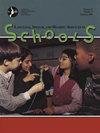学生、家长和教育者对说明文干预和延续的看法的定性调查。
IF 2.9
3区 医学
Q1 AUDIOLOGY & SPEECH-LANGUAGE PATHOLOGY
Language Speech and Hearing Services in Schools
Pub Date : 2025-09-17
DOI:10.1044/2025_lshss-25-00010
引用次数: 0
摘要
目的:本定性研究探讨了素描和说话说明性策略干预的社会有效性,因为它发生在一个单例实验中,并支持对有语言学习障碍(LLDs)的青少年的延续。方法对四名患有LLD的八年级学生进行夏季干预,教他们做笔记、生成口语句子、口头练习句子和报告,以帮助他们回忆信息文本中的想法。干预后,对青少年、其父母和提供干预的语言病理学家(SLP)进行访谈。在秋季,学校的SLP和三位老师使用这些策略设计并实施了课堂课程。然后对学生和教育工作者进行访谈,了解他们对语言干预和课程学习的教学策略的效用的看法。采用定性专题分析对访谈进行分析。结果根据两组(即学生和成人)的访谈数据得出了六个主题:(a)学生对教学策略的认识,(b)学生对学术使用策略的不确定性,(c)家长对干预效果的看法,(d)不同学习者的不同益处,(e)策略实施的难易程度,以及(f)合作和学校环境作为实施支持。结论:本定性研究显示,患有LLD的青少年、他们的父母和他们的教育者认为素描和说话策略在治疗和课堂应用中是有帮助的,尽管学生的热情不如教育者。slp和教师对这些策略的简单性、有效性和激励效果表现出强烈的认同,即使只进行了最少的后续培训。本文章由计算机程序翻译,如有差异,请以英文原文为准。
A Qualitative Inquiry of Student, Parent, and Educator Perceptions of an Expository Intervention and Carryover.
PURPOSE
This qualitative study explored the social validity of Sketch and Speak expository strategy intervention as it occurred within a single-case experiment and supported carryover for adolescents with language learning disabilities (LLDs).
METHOD
Four eighth-grade students with LLD participated in a summer intervention in which they were taught to take notes, generate oral sentences, and orally practice sentences and reports to help them recall ideas from informational texts. After intervention, the adolescents, their parents, and the speech-language pathologist (SLP) who provided the intervention were interviewed. In the fall, the school SLP and three teachers designed and carried out classroom lessons using the strategies. The students and educators were then interviewed about their perceptions of the utility of the taught strategies for language intervention and curricular learning. A qualitative thematic analysis was used to analyze the interviews.
RESULTS
Six themes emerged from the interview data according to two groups (i.e., students and adults): (a) student awareness of the taught strategies, (b) student uncertainty about the strategies for academic use, (c) parent perceptions of intervention effects, (d) different benefits for different learners, (e) ease of strategy implementation, and (f) collaboration and school context as implementation supports.
CONCLUSIONS
This qualitative study revealed that adolescents with LLD, their parents, and their educators perceive Sketch and Speak strategies as helpful within treatment and classroom applications, though the students were less enthusiastic than the educators. The SLPs and teachers showed strong buy-in for the simplicity, effectiveness, and motivational effects of the strategies, even with minimal carryover training.
求助全文
通过发布文献求助,成功后即可免费获取论文全文。
去求助
来源期刊

Language Speech and Hearing Services in Schools
Social Sciences-Linguistics and Language
CiteScore
4.40
自引率
12.50%
发文量
165
期刊介绍:
Mission: LSHSS publishes peer-reviewed research and other scholarly articles pertaining to the practice of audiology and speech-language pathology in the schools, focusing on children and adolescents. The journal is an international outlet for clinical research and is designed to promote development and analysis of approaches concerning the delivery of services to the school-aged population. LSHSS seeks to advance evidence-based practice by disseminating the results of new studies as well as providing a forum for critical reviews and meta-analyses of previously published work.
Scope: The broad field of audiology and speech-language pathology as practiced in schools, including aural rehabilitation; augmentative and alternative communication; childhood apraxia of speech; classroom acoustics; cognitive impairment; craniofacial disorders; fluency disorders; hearing-assistive technology; language disorders; literacy disorders including reading, writing, and spelling; motor speech disorders; speech sound disorders; swallowing, dysphagia, and feeding disorders; voice disorders.
 求助内容:
求助内容: 应助结果提醒方式:
应助结果提醒方式:


